Dan Matthews
CTO, IFS
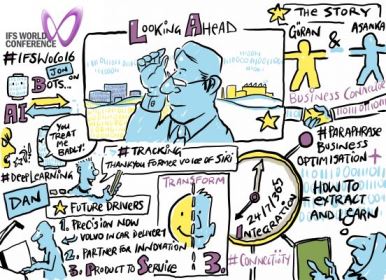
What is digital transformation to your business? How can you go about it in a pragmatic way? And how can we help?
Let’s look at an example: Volvo in-car delivery allows you stop shop online and have goods delivered to the trunk of a car when it’s at work. Volvo gives a temporary digital key that only allows access to the trunk.
Transformation happens in stages:
- Do what you’re doing today better. Collect data, analyze it and use it to make processes better. Deliver services better. Plan better products.
- Innovating new products and services. Take that data and combine with new relationships to create new products. You can move from a product sale to a service sale.
The Volvo operation is an example of that.
Where do you start? You start by becoming an agile business – a business that has systems that help, not hinder, when you want to change. And you also need to become a connected businesses, both to your staff and your clients, but also to your equipment and products, through the internet of things (IoT). And you need to be an intelligent business that uses the data your connecting to generate insights that help you compete better and transform faster.
A four step guide to IoT-based business transformation
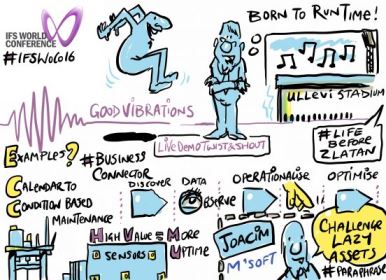
- Connect up your assets – a lot of your equipment probably have sensors on them already. The trick is getting the data from them continuously.
- Discover in your data – once you have the data, use it. If you’re worried about freezing temperatures in a room and the damage that comes with it, you fill the room with sensors. You don’t need to know the temperature in real time, just if it’s been below zero for a sustained period. Combine with forecast data, and you could send a heat blower to avoid the problem.
- Turn observations into actions – you don’t start making money rather than spending money until you turn those observations into operations actions.
- Optimize the business – and that moves you to an optimized business situation where historical and predictive data allow you to predict your needs and manage staff and equipment.
We really want to help you with the operationalize part of that process, which is why we are launching the IFS IoT Business Connector. We have a reference architecture for using IoT with IFS Applications, Field Service Management (FSM) and Enterprise Operational Intelligence (EOI). And there are open APIs for bringing other data and analysis.
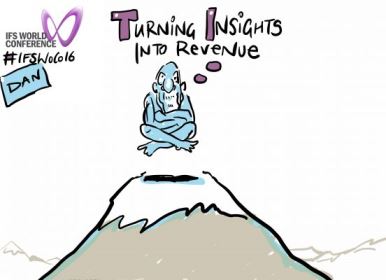
We’re woking with four early adopters:
- Anticimex – a pest control company that will be using connected rat traps so they can remotely monitor, empty traps as needed and pre-schedule battery service.
- Songa Offshore – they are using the IoT Business Connector to move from calendar-based maintenance to conditional maintenance. In oil rigs, a day’s shutdown can cost nearly half a million dollars…
- Hecla Mining company – another industry where shutdowns are very expensive
- ATS – want to use it to provide a higher level of service maintenance
Back at the Discovery phase, we’re working with partners like Microsoft Azure IoT Suite to get you the data.
Joacim Damgard
General Manager, Microsoft Sweden
There are a lot of assets out there that are not efficient. We are setting out to change that.
We are trying to move from a product-centric environment to a service-centric one. An example is connected elevators, which can predict what maintenance they will need and when, through machine learning. Predictive analytics can identify when drills are going bad, possibly ruining product.
You need to understand your assets, understand the data you can get and prepare for a cumbersome process of scaling up and connecting devices, but also look for a business model to justify it.
Dan Matthews
Many of you are thinking of your first projects – what you could go ahead with now. Well, the IoT Business Connector is only our first product in this space. We have four pillars:
- Pragmatic – what can we do to deliver this fast and at a good cost
- End-2-End – we need to connect the whole chain together, to create insights that the business can execute
- Evolutionary – we’ll support you taking an evolutionary approach to business transformation, but we’ll also evolve our products in the market
- Application Focus – this has to be relevant on the floor, not just to an IT consultant.
On to the Intelligent Business

Dashboards and displays matter. They give us at-a-glance views of a common picture of truth. We can use colors for performance and status, and they allow you to actively manage and take action. This is as true at NASA mission control as it is an IFS lobby.
You want to see business transformation, you need a Mission Control for your whole business. And that’s what IFS EOI is for. A single, visual version of the truth of the company. It’s a tool to get your strategy delivered.
We start by creating a map of your business. Who are your stakeholders? What are the processes and channels? Then we monitor performance by hooking into your business systems. Lastly, we put in place the workflows to take action on what you’re seeing to manage it. If you’re to be successful, you need to move quickly. We built this to support quick, iterative delivery.
We acquired this product with Visionwaves, doubled the investment, moved to monthly updates.
And now we’re releasing a new version: IFS Enterprise Operational Intelligence 8.1. It allows to maps your business, overlay KPIs on that map, and then take actions and make decisions based on what you can see.
You can:
- Monitor on customer maps, from floor plans to business strategy
- Updated user experience
- IFS IoT Business Connector integration
- IFS Dynamic Scheduling Engine integration
- Deepened IFS Applications integration
It’ll be released to the market in early 2017. The Edwards Companies are our early adopter right now.
Business 4.0
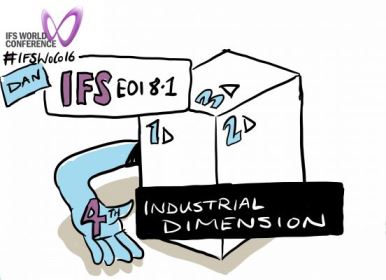
We’re in the fourth era of business applications:
Agile. Connected. Intelligent.
We’ll continue to develop our applications so you’re ready for these times.
Micael Dahlén
Professor, Stockholm School of Economics
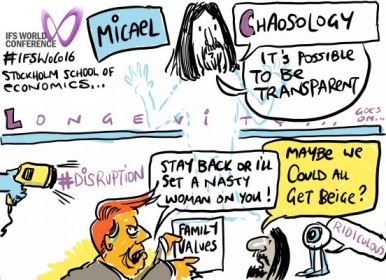
Congratulations on living in a time and space when anything can happen. You can be transparent – literally. We have made a transparent mouse fetus. We could make a transparent human – once the legal situation is sorted. They can inject nanoparticles of gold into a human, where it zooms around the body until it all gets stuck in a tumor. It’s really easy to heat up gold – put something like a hairdryer there and you can literally burn away the cancer. In a couple of decades, we might be able to live to be 200 years old.
I rely on research. For example, genomic research suggests that in the future we’ll have darker skin due to pigmentation helping survival and interbreeding between populations blending skin color, and, we’ll have huge eyes. We’ll need them to take in so much information through widescreen lenses – and our widescreen eyeballs.
How far away is the future? Nine meters
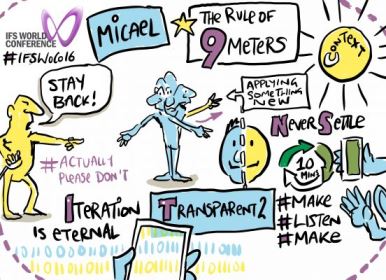
The future is closer than you think. It’s only nine meters away. It’s decided by what happens within nine meters of where you sit every day. Spotify was born of two guys sat within nine meters of each other in a basement office. The Olympic gold medallist in javelin was a Kenyan. That’s not a country with a tradition of javelin! How did it happen? He saw a guy on a bus watching javelin videos on YouTube and he started teaching himself from YouTube!
Of the 10 most valuable brands in the world, five weren’t there 10 years ago. 50% of the value of the top 100 brands is created by brands not on the list 10 years ago. This is the other side of the 9-meter rule. Companies that were innovative get stuck in the same old nine meters. Why do we have right-hand traffic in most of Europe? It dates back to everybody traveled by foot or horse and they wanted their sword hand facing the traffic. And to reduce road rage, it was decided to switch in France, and that sped through Europe thanks to Napoleon’s “PR” campaign.
You don’t need to be just one company anymore. There are a thousand different Amazons, as they experiment with their site every day. You can do this yourself! That can be my next tweet, and it will start proactively creating tweets for you. OnePlus is the Apple of China – or will Apple become the OnePlus of the US? They only do limited runs of phones – 30,000 which sell out in 10 minutes – and listen for feedback. They keep iterating like that.
Weather matters. Weather correlates with election results. People vote more for the incumbents when it’s sunny. On overcast mornings, the stock market will tend to go down.
The transitory nature of happiness
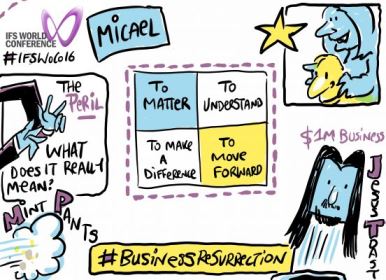
Anything is possible! I find this so exciting! I’m not sure you all do. I’ve been studying happiness amongst half a million people across the world and this is what I’ve found:
Happiness is just a bump in the road.
Whatever you do, it won’t last – so just hang in there.
But this is what makes you happier every day:
- To understand
- To matter
- To make a difference
- To move forward
Really, anything can happen. The Jesus toaster is a $1M business – it toasts pictures of Jesus into bread. A couple decided to devote their life to resurrecting Jesus from a toaster – every morning. How do you recognize a good business idea? If you look at something, realize it’s completely new to you and feel it would complete your life: it’s a good idea. Kickstarter works by allowing people to make a difference and to matter to new businesses.